THE INTERNATIONAL RELATIONS
1. THE RUSSIA AND UKRAINE CONFLICT
THE CONTEXT: The amid tension on the Russia-Ukraine border represents a major security crisis for the
region, with the potential to snowball into a broader conflict. According to Ukraine Government, Russia has
amassed around 90,000 troops at the border, and US intelligence reports that a Russian invasion of Ukraine
early 2022.
THE EXPLANATION:
Russia’s and the West’s interests in Ukraine:
- Ukraine and Russia share hundreds of years of cultural, linguistic and familial links. As part of the
Soviet Union, Ukraine was the second-most powerful Soviet republic after Russia, and was crucial
strategically, economically and culturally. Ever since Ukraine split from the Soviet Union, both Russia
and the West have vied for greater influence in the country in order to keep the balance of power in
the region in their favour. - For the United States and the European Union, Ukraine is a crucial buffer between Russia and the
West. As tensions with Russia rise, the US and the EU are increasingly determined to keep Ukraine
away from Russian control. - Efforts to induct Ukraine into NATO have been ongoing for many years and seems to have picked up
pace recently. Russia has declared such a move a “red line”, with Moscow worried about the
consequences of the US-led military alliances expanding right up to its doorstep.
What was Euromaidan and its aftermath?
- November 2013 saw the start of mass protests across Ukraine, but particularly in Kyiv’s Maidan, or
central square. Protesters were angry at Ukraine’s then pro-Russia President Viktor Yanukovych’s
decision to join the Russia-led Eurasian Economic Union instead of the EU. - The protests, known as the Euromaidan movement, saw massive clashes between the protesters
and security forces that reached its peak in February 2014, and led to the ouster of Yanukovych.
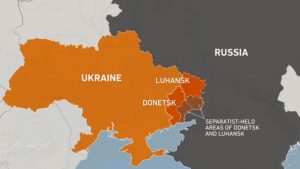
Current Scenario:
- Russia seeks assurances from the US that Ukraine will not be inducted into NATO. However, US has
made it clear that he is not prepared to give any such assurance. This has left the countries in a
stand-off, with tens of thousands of Russian troops ready to invade Ukraine. - Russia is keeping the tensions high at the Ukraine border in order to get sanctions relief and other
concessions from the West. Any kind of military action by the US or EU against Russia would
precipitate a major crisis for the whole world and has so far not been mooted by any of the parties
involved.
Value Addition:
MINSK I:
Ukraine and the Russian-backed separatists agreed on a 12-point ceasefire deal in the capital of Belarus in
September 2014.
Its provisions included:
- prisoner exchanges,
- deliveries of humanitarian aid and
- the withdrawal of heavy weapons
- the agreement quickly broke down, with violations by both sides.
MINSK II:
- Representatives of Russia, Ukraine, the Organisation for Security and Cooperation in Europe
(OSCE) and the leaders of two pro-Russian separatist regions signed a 13-point agreement in
February 2015 in Minsk. - The leaders of France, Germany, Russia and Ukraine gathered there at the same time and issued a
declaration of support for the deal.
THE ENVIRONMENT AND ECOLOGY
2. RARE PRISTINE CORAL REEF FOUND OFF TAHITI COAST
THE CONTEXT: The Scientists have explored a rare stretch of pristine corals shaped like roses off the coast of
Tahiti. The reef is thought to be one of the largest found at such depths and seems untouched by climate
change or human activities.
 THE EXPLANATION:
THE EXPLANATION:
- Globally, coral reefs have been depleted from overfishing
and pollution. Climate change is also harming delicate
corals, including those in areas neighboring the newly
discovered reef, with severe bleaching caused by warmer
waters. - According to a 2020 report by the Global Coral Reef
Monitoring Project, between 2009 and 2018, 14 of the
world’s corals were killed. - The newfound reef stretching 2 miles 3 kilometers was studied late 2021 during a dive expedition
supported by UNESCO. Unlike most of the world’s mapped corals, which are found in relatively
shallow waters. This one was deeper, between 115 feet 35 meters to 230 feet 70 meters.
Importance of Corals:
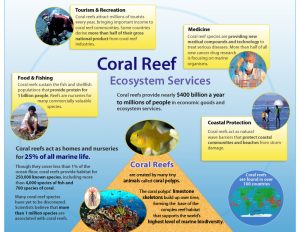
What is coral bleaching?
When corals are stressed by changes in conditions such as temperature, light, or nutrients, they expel the
symbiotic algae living in their tissues, causing them to turn completely white.
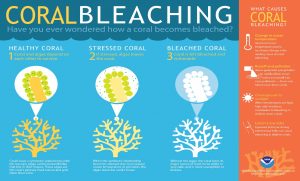
THE INTERNAL SECURITY
3. INDIA SUCCESSFULLY TEST-FIRES BRAHMOS MISSILE
THE CONTEXT: The supersonic cruise missile BrahMos with increased indigenous content and improved
performance was successfully flight-tested from the Integrated Test Range, Chandipur off the coast of
Odisha.
THE EXPLANATION:
- According to DRDO, the missile was equipped with the advanced indigenous technologies and
followed a modified optimal trajectory for enhanced efficiency and improved performance. The
missile with the modified control system has been fine tuned to achieve an enhanced capability’. - The flight test was monitored by all the sensors of the range instrumentation, including telemetry,
radar and the electro-optical tracking systems deployed across the eastern coast and the down
range ships.
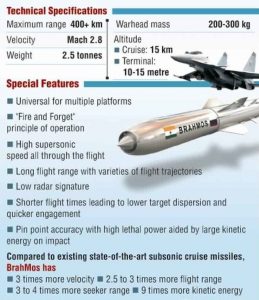
About the Missile:
- BrahMos Missile is a medium-range ramjet supersonic cruise missile. It can be launched from land,
aircraft, submarine or ships. It is one of the fastest supersonic cruise missiles worldwide. The missile
is a joint venture between the Russia’s NPO Mashinostroyeniya and India’s Defence Research and
Development Organisation (DRDO). - Both the organisation has together formed BrahMos Aerospace. It is based on Russian P-800 Oniks
cruise missile. The name BrahMos has been taken from the names of two rivers, River Brahmaputra
of India and River Moskva of Russia.
Characteristics of BrahMos
- BrahMos is the fastest anti-ship cruise missile of the world, currently in operation. Its land-launched
and ship-launched versions are already there in service. In 2012, air-launched variant of BrahMos
appeared and entered the service in 2019. - Presently, a hypersonic version of the Missile called BrahMos-II, is under development. It has the
speed of Mach 7–8. Missile is likely to be ready for testing by 2024.
4. THE GENETIC RISK FACTORS FOR HEART FAILURE: STUDY
THE CONTEXT: A team of scientists at the CSIR-Centre for Cellular and Molecular Biology (CCMB),
Hyderabad, have identified the genetic mutations that cause dilated cardiomyopathy, a common
cardiovascular disease that often results in heart failure.
THE EXPLANATION:
- Cardiomyopathy changes the integral structure of the heart muscle, and as a result, the heart is
unable to pump blood efficiently. This increases the risk of heart failure leading to sudden cardiac
death. There are many types of cardiomyopathies. Dilated cardiomyopathy is the most common
form. - A gene called β-MYH7 is one of the major genes implicated in cardiac diseases globally. However,
not many genetic studies have been carried out on Indian cardiomyopathy patients. - In the study, the CCMB researchers chose to fill the gap by sequencing the β-MYH7 gene from 137
dilated cardiomyopathy patients along with 167 ethnically matched healthy controls to identify the
mutation(s), if any, that are associated with dilated cardiomyopathy in Indian patients. - The study revealed 27 variations, of which seven were novel and were detected exclusively in Indian
dilated cardiomyopathy patients. These included four which were what are called missense
mutations. They were predicted to be pathogenic by bioinformatics tools. - Subsequent studies using homology models of β-MYH7 demonstrated how these mutations
uniquely disrupt a critical network of non-bonding interactions at the molecular level and may
contribute to the development of disease phenotype. - Protein molecules are made up of amino acids and each of them has a specific set of amino acids.
Various interactions between the amino acid residues drive the 3D structure of the protein, which
determines its function. One amino acid change at a critical site can change a protein structure
dramatically and lead to disease pathogenicity. - According to the scientist, “this study can help in developing gene-editing methods that may rescue
cardiac contractility of failing hearts among Indians with the novel mutations”. The mortality rate
due to cardiovascular diseases is very high in India, compared to western countries.
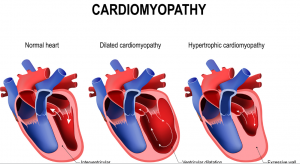
What is Cardiomyopathy?
It (kahr-dee-o-my-OP-uh-thee) is a disease of the heart muscle that makes it harder for your heart to
pump blood to the rest of your body. Cardiomyopathy can lead to heart failure. The main types of
cardiomyopathy include dilated, hypertrophic and restrictive cardiomyopathy.
THE PRELIMS PRACTICE QUESTIONS
QUESTION OF THE DAY 20 TH JANUARY 2022
Q1. Consider the following statements about Brahmos missile:
- It is a ballistic missile.
- It can be launched from land, sea, sub-sea and air.
Which of the statements given above is/are correct?
a) 1 only
b) 2 only
c) Both 1 and 2
d) Neither 1 nor 2
ANSWER FOR 19 TH JANUARY 2022.
Answer: C)
Explanation:
- Statement 1 is correct: The eastern swamp deer is one of the three subspecies of swamp deer,
commonly known as the barasingha. - Statement 2 is correct: The eastern swamp deer is endemic to Kaziranga.

